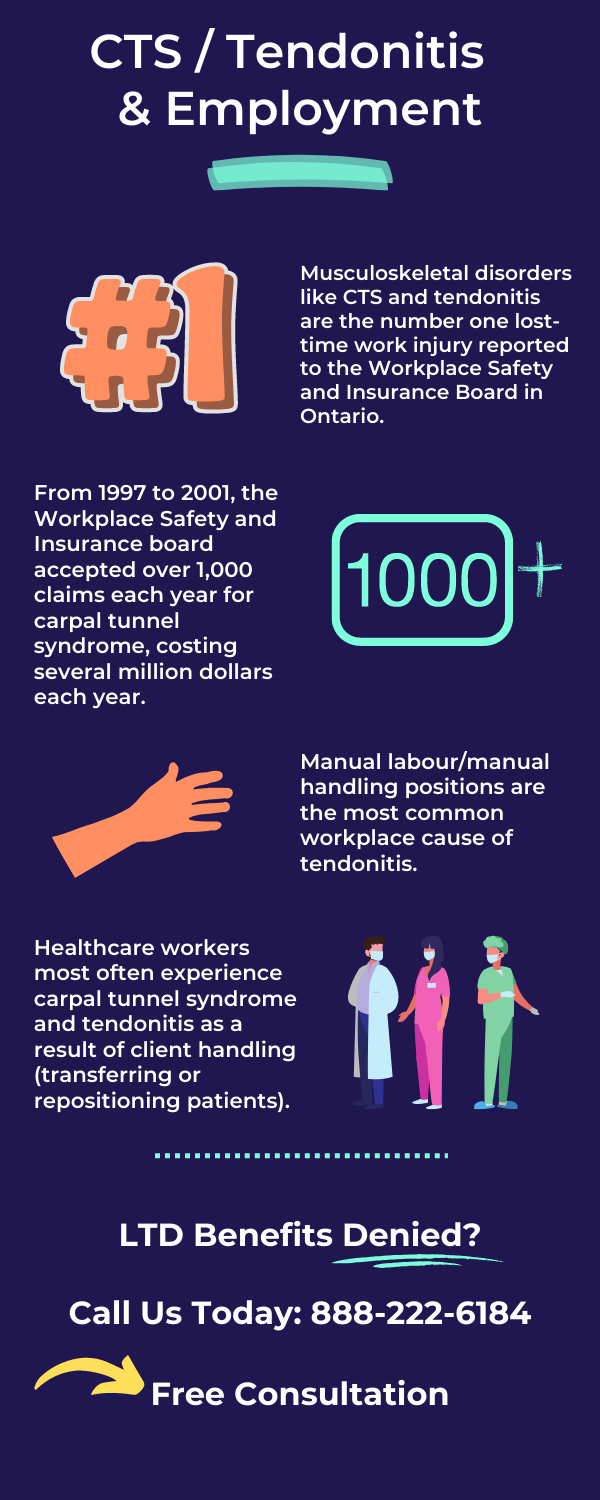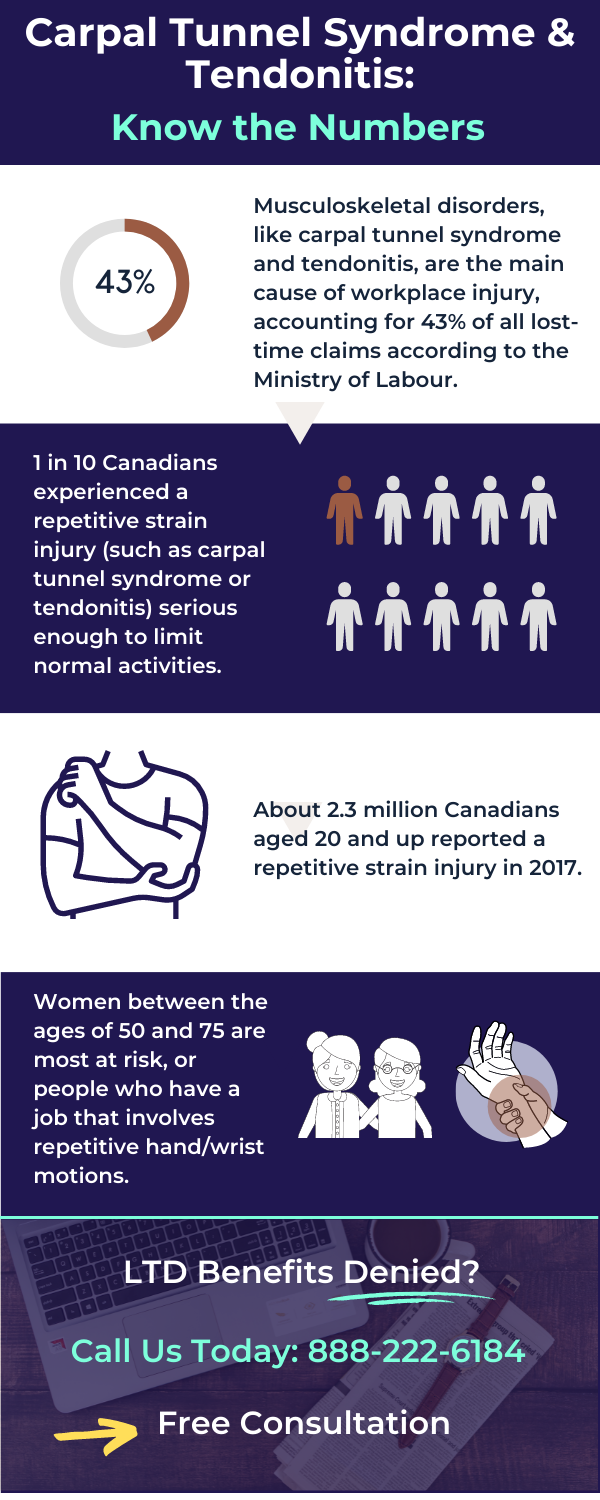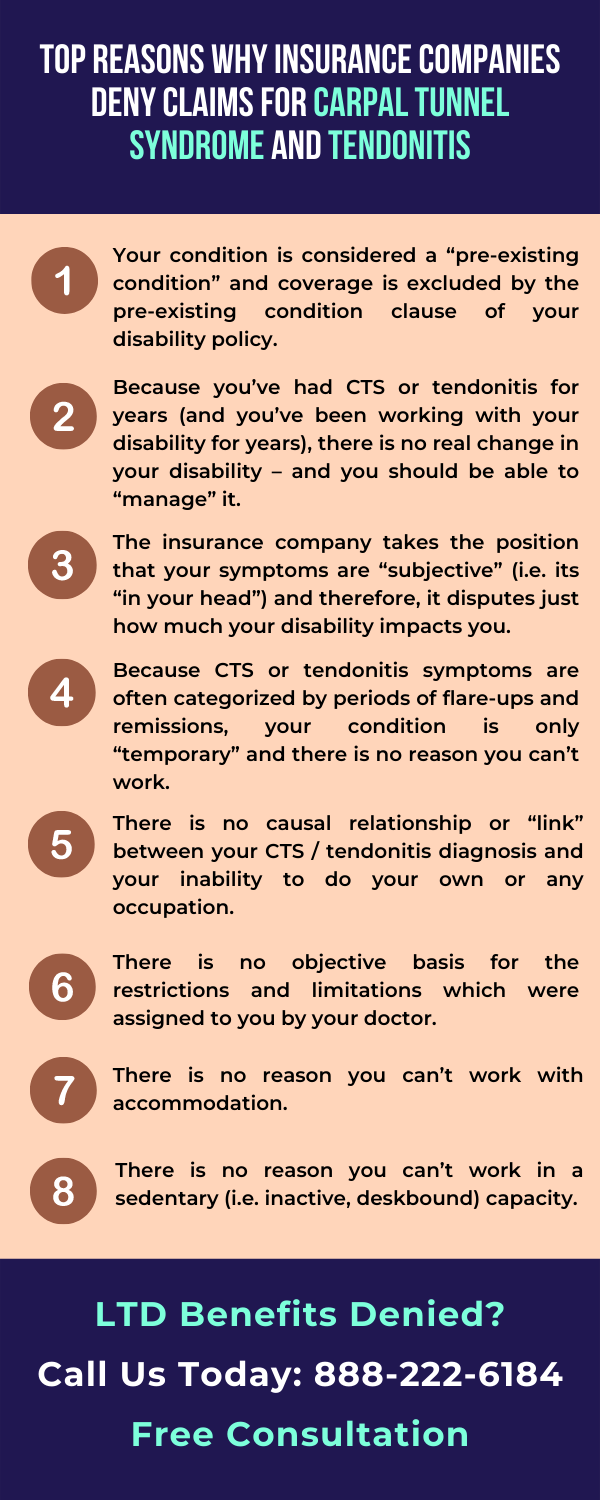Do I qualify for long-term disability benefits if I have Carpal Tunnel Syndrome or Tendonitis?
Can I Get Long-Term Disability Benefits for Carpal Tunnel Syndrome or Tendonitis?
One of the most common questions we get is “Do I qualify for long-term disability benefits if I have Carpal Tunnel Syndrome/Tendonitis?”
Carpal Tunnel Syndrome and Tendonitis are both musculoskeletal disorders, and are considered repetitive strain injuries.
Carpal tunnel syndrome affects the hand and wrist and occurs when, through repetitive or excessive movement, the lubrication system in the wrist does not work.
Tendonitis is when the tendon, usually in the hand, wrist, shoulder or elbow, becomes inflamed or irritated.
Both can qualify for long-term disability benefits!
Has your claim for disability benefits been denied? Has the insurance company denied your appeal? Were you receiving benefits and the insurance company terminated those benefits?
Our Long-Term Disability Insurance Lawyers offers:
✓ A free case assessment
✓ Fair, flexible rates, including contingency fees (i.e. only pay if you win)
✓ Service across all of Ontario
We’ll work with you and your physician to help challenge the insurance company’s denial or discontinuance of your long-term disability benefits.
Where necessary, we will engage other trusted professionals to support your case including specialists, functional capacity evaluators, and vocational evaluators to help credibly explain why your disability symptoms are preventing you from doing your “own occupation” or “any occupation
Carpal Tunnel Syndrome/Tendonitis: Key Facts
Carpal Tunnel Syndrome and Tendonitis tend to be grouped together as they often can accompany each other in diagnosis.
Carpal tunnel syndrome develops when there is a malfunction in the lubricating system in the hand/wrist. This causes friction between the tendon and its sheath which causes inflammation and swelling. Over time, fibrous tissue can build up and can stop the tendon from moving its full range.
Tendonitis can also be caused by repetitive or excessive movements, like carpal tunnel syndrome, but can also occur as a result of forceful exertion, strange postures, vibration or mechanical stress. The tendon can then tear apart and trigger an inflammatory response in the body. Over time, the inflamed tendons can get thicker and irregular and, if not treated correctly, can permanently weaken. Tenosynovitis is similar to tendonitis and carpal tunnel syndrome in that it is an inflammation of the tendon sheath caused by a lack of synovial fluid which lubricates the tendon.
The cause of Carpal Tunnel Syndrome/Tendonitis is usually through a combination of things such as overuse, age, injury or disease. However, if you are performing repetitive tasks, experience excessive force to the area, vibration, strange postures or a lot of overhead reaching, your risks for developing carpal tunnel syndrome and/or tendonitis is greater.
See: Workplace Safety North and Ministry of Labour.
Most Common Symptoms of Carpal Tunnel Syndrome/Tendonitis
Carpal Tunnel Syndrome
The most common symptoms:
- tingling of the thumb, index, middle and ring fingers
- weakness in the hands
- difficulty pinching and grasping
- dropping items
- pain in the hands, wrists, shoulders, and arms
- numbness and loss of dexterity
- dry skin[3]
Tendonitis
The most common symptoms of tendonitis include
- pain at the site of the injury
- decreased strength or functional ability
- tenderness in the area
- swelling
- redness
- restriction in movement.[4]
Criteria for a Diagnosis of Carpal Tunnel Syndrome/Tendonitis
In order to diagnose carpal tunnel syndrome, your doctor will ask you a series of questions about your job to identify if you are at risk based on your typical job duties. Your doctor will need a complete description of your job duties including what you do, how long you do it for and how regularly you perform the task.
There three tests to determine your diagnosis:
Tinel’s test: tapping of the median nerve at the wrist. If you experience a tingling sensation in one or more fingers, it indicates damage to the median nerve.
Phalen’s test: place the backs of your hands together and bend the wrists for one minute. Tingling in the fingers indicates damage to the median nerve.
Electromyography: electrical current is passed through the patient by electrodes placed on the forearm. The median nerve is measured at how fast and how well it transmits messages to the muscle to indicate if there is damage.
Tendonitis is diagnosed through a physical examination and medical history by your doctor. Sometimes, you may require an x-ray, ultrasound or MRI. Tendonitis is often mistakenly diagnosed as arthritis, as the inflammation often occurs near the joint.[5]
Indeed, this is why long-term disability insurers often deny claims for Carpal Tunnel Syndrome/Tendonitis – because it can be difficult to diagnose accurately in its early stages.
Treatment for Carpal Tunnel Syndrome/Tendonitis
The most useful tool to treat carpal tunnel syndrome/tendonitis is to take preventative measures to avoid these conditions instead. The Canadian Centre for Occupational Health and Safety recommends redesigning your workspace or tools to prevent awkward wrist positions and minimized the stress of repetitive motions. Further, it suggests training to reduce the number of strange positions for the wrist and how to reduce repetitive movement.
Home Remedies
If you are experiencing mild carpal tunnel syndrome/tendonitis you can often treat it at home by refraining from performing the activities that cause pain, applying ice to the painful area, taking non-steroidal anti-inflammatory medications and wearing a wrist splint.
Chiropractor
Visiting a chiropractor can help alleviate some symptoms of carpal tunnel syndrome/tendonitis. Chiropractors use laser, ultrasound, shockwave therapy or nerve-gliding to assist with treating carpal tunnel syndrome/tendonitis. They may also prescribe a wrist splint, depending on severity.[6]
Physical or Occupational Therapy
Physical or occupational therapy can assist in strengthening the affected area and prevent further issues in the future. This treatment can also help stretch the affected muscles and tendons.
A recent study indicates that people diagnosed with carpal tunnel syndrome who were waiting for surgery were prescribed a splint and sessions with an occupational therapist. At the end of the study, it was found that symptom severity, function, pain and grip strength all improved.[7]
Medication
Medication such as corticosteroids, platelet-rich plasma and anti-inflammatory medications may be prescribed to help treat the symptoms.
Surgery
For carpal tunnel syndrome, surgery may be recommended depending on the severity of the case. Surgery involves cutting the carpal ligament to allow more space for the nerve. The recovery process from such a surgery tends to be several months.
Important: These surgeries also can be the basis of a disability claim.
Carpal Tunnel Syndrome/Tendonitis and Your Employment
In a study of 100,000 people over a period of 66 months, it was found that carpal tunnel syndrome occurred in 103 people. The occupations with the highest risk of developing carpal tunnel syndrome included skilled trades and administrative/secretarial positions.[8]
Carpal tunnel syndrome appears to occur more frequently in positions that require the use of pneumatic tools or those who work in a cold environment (e.g., logging, meat cutting). There is no documented link between carpal tunnel syndrome and computer/keyboard use and the repetitive use of a keyboard does not correlate to carpal tunnel syndrome, but does not necessarily mean you cannot develop it.[9]

Workplace Restrictions and Limitations Caused by Carpal Tunnel Syndrome/Tendonitis
In order to prevent and/or manage carpal tunnel syndrome/tendonitis in the workplace several accommodations may be required, such as:
- Requesting an ergonomic assessment of your workspace/work tools. Special grips, arm rests, desks, keyboards, etc., may be required.
- Frequent breaks to prevent stress on the injured area
- Take time to warm up the hands if you work in a cold environment throughout the day
- Insulated gloves for those who work in a cold environment
- Anti-vibration mounting or other engineering measures to prevent vibrations from affecting your hands
- Regular maintenance of your tools and workspace
- Alternate or change the position of your hands when working
- Rotate the functions of your job and vary tasks throughout the day
- You may be prescribe wrist supports
See our video: LTD Case Study: Carpal Tunnel Syndrome/Tendonitis
Carpal Tunnel Syndrome/Tendonitis and Workplace Discrimination
It is unlawful to discriminate against someone in the area of employment based on their physical disability: Ontario’s Human Rights Code and the Canadian Human Rights Act.
If you are suffering from Carpal Tunnel Syndrome/Tendonitis, you might face discrimination in a variety of ways:
- You experience termination of employment because you have Carpal Tunnel Syndrome/Tendonitis.
- You are denied accommodation because of your Carpal Tunnel Syndrome/Tendonitis.
- After returning from a disability leave, your employer places you in a lower, part-time position at a lower rate of pay
- Someone makes unwelcome remarks or jokes about your disability.
- Someone offends or humiliates you physically or verbally threatens or intimidates you because of your disability.
- Retaliating against you for filing a human rights complaint.
See our video:“Disability Discrimination”
Ertl Lawyers are disability and employment lawyers in Toronto. If you have been discriminated against, we can help, including:
- Having your employer comply with their duty to accommodate you.
- Having your employer stop all forms of discriminatory conduct.
- Representing you in wrongful dismissal, constructive dismissal, and human rights matters.
- Ensuring that your employer complies with its statutory obligations, including its obligations under the Employment Standards Act.
- Negotiation severance pay packages (including continuation of benefits).
What Are Some Steps You Should Take Before You Apply for Long-Term Disability Benefits for Carpal Tunnel Syndrome/Tendonitis?
Review Your Policy Carefully
Your entitlement to disability benefits for Carpal Tunnel Syndrome/Tendonitis depends on the specific wording of your disability policy.
Therefore, you will need to review your policy and see how it defines things like “totally disabled” and “occupation” – and whether any exclusions apply (particularly for pre-existing conditions).
Gather Medical Evidence
To be entitled to disability benefits for Carpal Tunnel Syndrome/Tendonitis, every insurer requires you to provide medical evidence documenting how your illness or injury causes restrictions or lack of ability, such that you are prevented from performing the essential duties of your occupation.
Therefore, you will need a copy of your medical records to see if there is an objective basis for your diagnosis of Carpal Tunnel Syndrome/Tendonitis and what your medical records say about your symptoms and your restrictions and limitations
Gather Evidence of Workplace Limitations
Because your entitlement to long-term disability benefits for Carpal Tunnel Syndrome/Tendonitis depends on the strength of your evidence, you should get a copy of your employee file from work. It may show that your Carpal Tunnel Syndrome/Tendonitis negatively impacted your work performance. Your work performance may have been affected by your frequent absences from work, pain, fatigue, etc.
Create a List of the Physical Duties of Your Job
You should get a copy of your job description. Based on that job description, you should write out a detailed list of the physical (and mental) duties associated with your job description – and explain how your Carpal Tunnel Syndrome/Tendonitis limits or prevents you from performing you own occupation.
Ask Your Doctor for a Report
It is recommended that you provide your doctor with your occupational description. You should ask your doctor to prepare a report that clearly explains the objective basis for:
- your diagnosis of Carpal Tunnel Syndrome/Tendonitis
- your restrictions and limitations
- reasons why you are unable to perform some or all of the essential duties of your own occupation.
Follow Your Doctor’s Treatment Plan
Your entitlement to long-term disability benefits also requires you to be receiving regular, ongoing care and treatment for your Carpal Tunnel Syndrome/Tendonitis. In other words, don’t skip appointments, and always follow your doctor’s treatment plans.
Keep a Pain Diary
On your end, it is important to keep a pain diary. A pain diary is a written record that helps you keep track of when you have pain, how bad it is, and whether your treatment is helping.
What Other Benefits Might I Be Entitled to for Carpal Tunnel Syndrome/Tendonitis?
Other than short-term and long-term disability benefits through a group or individual insurance plan, people suffering from Carpal Tunnel Syndrome/Tendonitis might be entitled to one or more of the following benefits:
- Employment Insurance (EI) Sickness Benefits;
- Ontario Disability Support Plan (ODSP);
- Disability Tax Credit (DTC);
- Disability Creditor Insurance (under your mortgage or credit cards);
- Trillium (extended health benefits);
- Canada Pension Plan Disability (CPP-D); and
- Disability Pension (employer).
Carpal Tunnel Syndrome/Tendonitis Organizations / Associations / Colleges
- Canadian Othopaedic Foundation
Endnotes:
1. Workplace Safety North. Is your job causing you pain? February 13, 2018. Retrieved from: https://www.workplacesafetynorth.ca/news/news-post/your-job-causing-you-pain
2. Government of Ontario. Ministry of Labour. Ergonomics in the workplace. Retrieved from: https://www.ontario.ca/page/ergonomics-workplace
3. Government of Canada. Canadian Centre for Occupational Health and Safety. OSH Answers Fact Sheet, updated November 26, 2019. Retrieved from: https://www.ccohs.ca/oshanswers/diseases/carpal.html
4. Government of Canada. Canadian Centre for Occupational Health and Safety. OSH Answers Fact Sheet, updated July 15, 2019. Retrieved from: https://www.ccohs.ca/oshanswers/diseases/tendon_disorders.html
5. Canadian Orthopaedic Foundation. Bursitis and Tendonitis. Retrieved from: https://whenithurtstomove.org/about-orthopaedics/conditions-and-ailments/arthritis/bursitis-and-tendonitis/
6. Canadian Chiropractic Association. 2020. Retrieved from: https://www.chiropractic.ca/blog/carpal-tunnel-syndrome/
7. Squissato V., Brown G. CMAJ Group. Carpal tunnel syndrome. August 5, 2014, Retrieved from: https://www.cmaj.ca/content/186/11/853
8. Jackson D.W., Simmons B.P.. Treatment of carpal tunnel syndrome depends on many variables. September 10, 2012. Retrieved from: https://www.healio.com/news/orthopedics/20120911/treatment-of-carpal-tunnel-syndrome-depends-on-many-variables?utm_source=TrendMD&utm_medium=cpc&utm_campaign=Healio__TrendMD_1
9. Watts R.J., Osei-Tutu K.B., Lalonde D.H., Can J Plast Surg. 2003 Winter.US National Library of Medicine National Institutes of Health. Carpal tunnel syndrome and workers’ compensation: A cross-Canada comparison. Retrieved from: https://www.ncbi.nlm.nih.gov/pmc/articles/PMC3760749/
Disclaimer: The content on this web site is provided for general information purposes only and does not constitute legal, medical, or other professional advice or an opinion of any kind. Users of this web site are advised to seek specific legal advice by contacting members of Ertl Lawyers (or their own legal counsel) regarding any specific legal issues. Ertl Lawyers does not warrant or guarantee the quality, accuracy or completeness of any information on this web site.
Long-Term Disability Benefits Denied?
Ertl Lawyers provides expert representation in long-term disability matters.
The vast majority of disability matters are resolved through negotiation and mediation – and that’s because insurance companies know that we are passionate about our clients’ rights.
How we can help you:
• free disability policy analysis
• free case assessment
• applying for disability benefits
• appealing a denial or termination of your benefits
• disputing a denial through a legal claim
• handling all communications with your employer
• protecting your employment
• prosecuting human rights claims
Fair, Flexible Rates – Including Contingency Fees
(Don’t Pay Unless You Win)
Our Help Can Make All The Difference.
Related Blogs
Why Long-Term Disability Claims Get Denied by Insurance Companies
Injuries and illnesses happen to everyone. But what if someone is severely injured in an accident that requires months of full-time medical care or develops a condition so overwhelming that they can no longer perform routine tasks? Many employer and self-provided...
Your Guide to Record of Employment in Ontario
If you’ve never had a Record of Employment (ROE) issued to you, you might confuse it for a T4 slip the first time you see it. While it looks like a simple, straightforward document containing standard information like your name, address and those of your former...
Workplace Sexual Harassment Laws in Canada
One in four women and 17% of men experienced sexual misconduct while in the workplace in Canada in 2020. Realistically, those numbers are probably higher. Employers are legally required to provide a safe, harassment-free workplace. Nobody should have to endure sexual...






